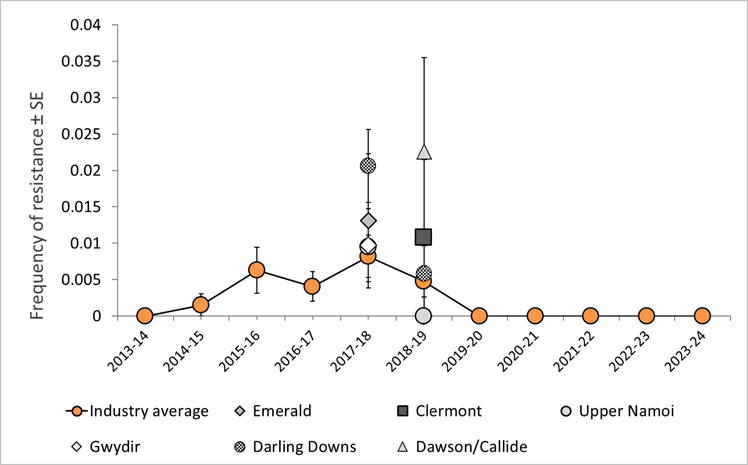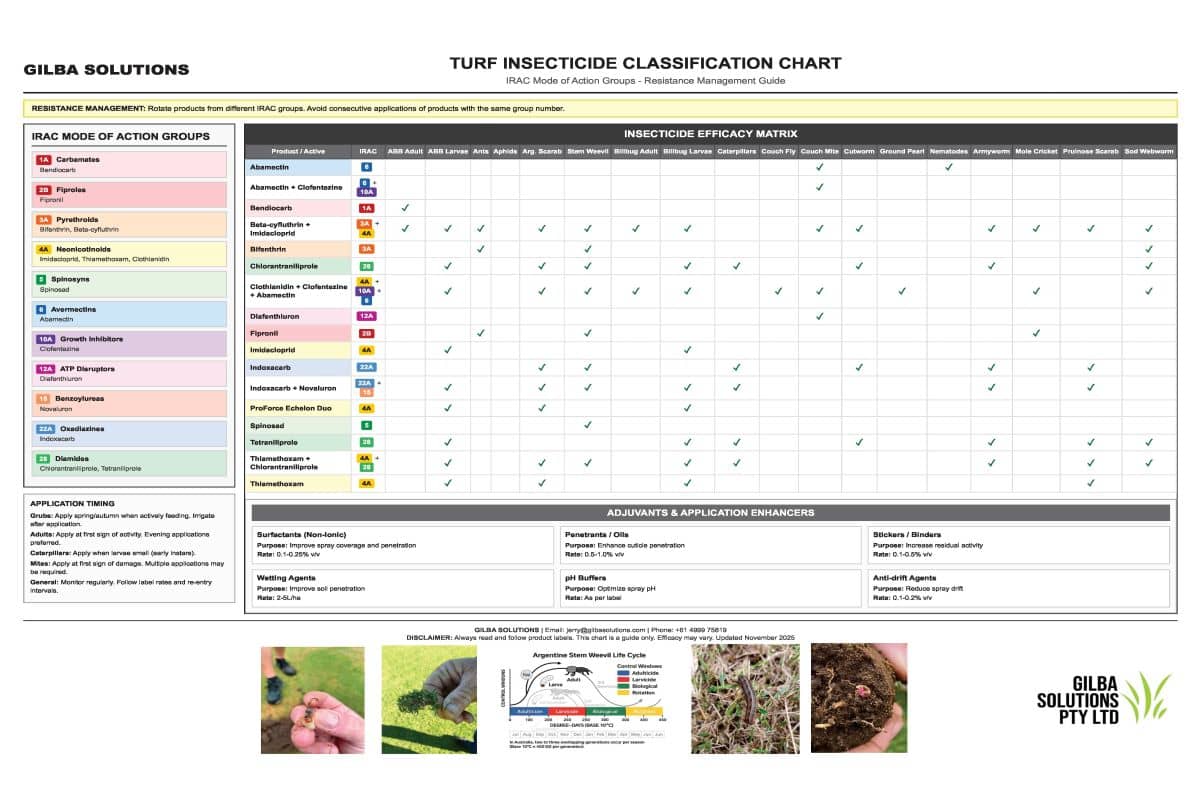Insecticide Resistance in Turfgrass.
If you continue to use insecticides from the same chemical group, and which have the same mode of action it:
- Pest species have a greater risk of resistance developing to that chemical group.
- Means the risk of cross-resistance to other groups increases.
Cross Resistance to Turf Insecticides.
A good example of cross resistance that relates to turf is the Argentine Stem Weevil.1Koppenhöfer AM, Kostromytska OS, Wu S. Pyrethroid-Resistance Level Affects Performance of Larvicides and Adulticides From Different Insecticide Classes in Populations of Listronotus maculicollis (Coleoptera: Curculionidae). J Econ Entomol. 2018 Aug 3;111(4):1851-1859. doi: 10.1093/jee/toy142. PMID: 29800225. Research shows that if stem weevil larvae are resistant to bifenthrin, it results in a reduction in the efficacy of cyantraniliprole (found in Spinner insecticide), indoxacarb (Provaunt) and clothianidin.
Resistance even develops in products where you might think there will not be any issues. Take chlorantraniliprole (Acelepryn). In agriculture in 2023/2024 no resistance was seen in the cotton bollworm or corn ear-worm. However, in previous years resistance has been seen to this chemical.
If you use chemicals that have different modes of action, this slows down the chances of pest species developing insecticide resistance. If you adopt this approach to resistance management in conjunction with certain cultural practices it is a good first step to slow down this entire process.
Cultural Practices to Prevent Insecticide Resistance.
The use of cultural practices to control an insect pest reduces the selection pressure from insecticides. Cultural controls include:
- The use of high endophyte sports turf seed varieties like A-listed perennial ryegrass. These are research proven to have better resistance to insect attack due to their high endophyte levels. An example of this is, Intense PRG.
- Ensure that your turf surface is in the best possible condition. This means mow at the right height, don’t overwater, and fertilise appropriately.
- Monitor insect threshold levels. If pest numbers are below acceptable thresholds then don’t spray an insecticide.
Soapy Water Test.
If you plan to monitor pest numbers the soapy water test is a good way to allow you to count insect numbers in the soil. The soap irritates army worms, adult billbugs, or mole crickets and the result is that they come to the soil surface.
Soapy Water Recipe.
- In 8 L of water add 30 ml lemon scented washing up liquid.
- Apply this mix in a watering can to one square metre of turf.
- Repeat every 14 – 21 days and count how many pests emerge after each treatment.
The other options is to use a Degree Day Model. All degree day models rely on the association between heat and insect development. These models can help better target insecticide applications so that you spray when they are at their most vulnerable.
Degree Day Models.
- Determine the Base Temperature. For Argentine Stem Weevil use 10°C.
- Establish a Start Date. This very much depends on your location. For example, Canberra is colder than Sydney. This means that the start date in Canberra is going to be later than in Sydney
- Track the daily temperature. Calculate the daily mean temperature (the average of the max + min).
- Then subtract the base temperature (10) to give the daily degree days.
- Keep a running total of the Degree Days. You can do this if you add up the daily degree days from the start date until the current date.
- Compare the running total to the action thresholds for the different stem weevil life stages.
- Use the right insecticide to target the life stage when the running total of degree days fall inline with the action thresholds.
Action Thresholds for Stem Weevil.
- Adult Peak Migration: 110-120 GDD.
- Eggs/Small Internal-Feeding Larvae: ~ 175 GDD.
- Larvae Emerging from Stems: ~ 350 GDD.
Understand an insect or mite life cycle.
It’s vital to understand the life cycle of a turfgrass pest. If you do this you are able to better target your control methods. In a resistance program you will get the best results from any insecticide or miticide if you target pests when they are at their most vulnerable.
The control spectrum of a product is also important. Many current products, are active against more than one pest, and provide several benefits from one application.
Reduces the Development of Resistance.
If you use products that have more than one mode of action, you introduce different selection pressures. This makes it more difficult for any resistance to develop.
Improved Control.
With the use of different chemical groups you can target different insect life stages or behaviour. This means you are able to target for example larvae or adults.
You Get Better Control.
You can create a synergy between actives when you combine insecticides with different modes of action.
Less Chemical Use.
If you mix lower doses of chemicals than if you use them alone, it means there is less of an impact on the environment.
A good example of this approach is ProForce Scarlet Trio. One application controls African Black beetle, mites, argentine stem weevil, mole crickets, cutworms, armyworms and sod webworms.
How to Get the Best Results from an Insecticide.
Insecticide Resistance Management Strategies.
Reasons for Insecticide Failure.
What is a Target Site?
- Where an insecticide binds and works, is known as its target site.
- Insecticide molecules are much smaller than the target protein molecules they work on.
- The target proteins can have multiple sites where similar insecticides can bind.
- How an insecticide interacts with the target site defines its mode of action.
How Mode of Action Helps Manage Insecticide Resistance.
References

Jerry Spencer
Jerry has an Hons Degree in Soil Science (1988) from Newcastle Upon Tyne University. He then worked as a turf agronomist for the Sports Turf Research Institute (STRI) until 1993.
He gained a Grad Dip in Business Management from UTS in 1999. He has held a number of technical roles for companies such as Arthur Yates (Commercial Technical Manager) and Paton Fertilizers (Organic, turf specialty and controlled release fertiliser) portfolios.
In 2013 he established Gilba Solutions as independent sports turf consultants and turf agronomists. Jerry has written over 100 articles and two books on a wide range of topics such as Turf Pesticides and turfgrass Nutrition which have been published in Australia and overseas.



